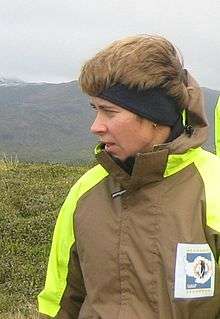Bettine van Vuuren
Bettine van Vuuren is a Professor of Zoology and Director of the Centre for Ecological Genomics and Wildlife Conservation at the University of Johannesburg.[1]
Bettine van Vuuren | |
|---|---|
 Bettine van Vuuren in 2006 | |
| Nationality | South Africa |
| Alma mater | B.Sc. (Hons) Zoology, University of Pretoria (1992)
MSc, University of Pretoria (1995) PhD in Zoology (2000) |
| Scientific career | |
| Fields | Zoology |
| Institutions | University of Johannesburg |
| Website | Bettine Jansen van Vuuren University of Johannesburg |
Early life and education
Bettine van Vuuren studied at the University of Pretoria, South Africa. She received a B.Sc. (Hons) Zoology in 1992 and M.Sc. in 1995. She was awarded a PhD in Zoology in 2000 on the topic 'Molecular phylogeny of duiker antelope (Mammalia: Cephalophini) .[2]
She subsequently relocated to the University of Stellenbosch and in 2001, took up a postdoctoral position at the University of Montpellier II, France. Her research focused on game mammals in French Guiana and the results contributed towards the development of hunting laws for the protection of Neotropical game species. In 2002, she returned to Stellenbosch University. She was invited to become a core team member of the Centre of Excellence for Invasion Biology (CIB) (2005 to 2014).[3][4]
In October 2011, she accepted a position at the University of Johannesburg (where she established the Molecular Zoology Laboratory), and in 2016 / 2017 she was awarded a University of Johannesburg research centre (Centre for Ecological Genomics and Wildlife Conservation). She has been involved with the supervision of > 40 PhD and MSc students and hosted >10 postdoctoral fellows. She is a member of the Zoological Society of Southern Africa, the International Biogeography Society and the Southern African Wildlife Management Association.
Career and impact
van Vuuren believes that aspects of her research must have practical conservation and management application. She has driven research documenting genetic patterns for several of Africa's economically important game species (such as roan and sable antelope, black rhino, nyala and buffalo). Through ongoing interaction, she feeds her research back to nature conservation, industry and the general public. To this end, she was involved (2005-2007, and again in 2013-2014) with the Draft Regulations for the Biodiversity Act (#10 of 2004) as the Coordinator for the listing on invasive vertebrate species (excluding fishes) and was largely responsible, in collaboration with Dr Preston (Deputy Director General: Environmental Programmes, Department of Environmental Affairs), for the listing of mammal species and associated distribution maps. She serves, when required, as a scientific adviser to the Department of Environmental Affairs: Directorates Biodiversity and Conservation (this work relates mostly to the translocation and permitting of antelope species), as well as Environmental Programmes (this includes work from an alien invasive perspective).
In addition to studying spatial patterns on the African continent, her research has a strong Antarctic / sub-Antarctic focus. She has worked extensively on Marion Island (of the Prince Edward Islands) as a project leader and was the first female Chief Scientist in the South African National Antarctic Programme's annual relief voyage in 2006.[5][6][7] She serves on the South African ICS Committee for the international Scientific Committee on Antarctic Research (SCAR) and was the National Alternate Delegate to the recent SCAR Delegates meeting in Davos, Switzerland, the South African representative to SCAR Life Sciences, and also the South African representative and co-Chair of a SCAR Action Group (focused on integrated sciences for the sub-Antarctic). Van Vuuren is an official South African delegate to the Scientific Committee on Antarctic Research and the Vice-Chair of the Standing Scientific Group on Life Sciences since 2010[8] and South African representative on for the Action Group on Integrated Science for the Sub-Antarctic.[9]
She is recognized nationally and internationally and attained leadership positions in academia and science outside a university setting (President: ZSSA – two terms; Vice-Chair: FBIP Steering Committee; Vice-Chair: ICSU SANC for the Scientific Committee on Antarctic Research (SCAR); SA Delegate to SCAR; SA Representative on various SCAR Life Science groups and working groups; etc.). She has strong national (academia, SANBI, government, industry, etc.) and international (CIBIO Portugal, University of Kiel Germany, Australian Antarctic Division, University of Queensland Australia etc.) collaborations.
References
- "Prof Bettine van-Vuuren". www.molzoolab.co.za/. Archived from the original on 2018-03-08. Retrieved 2016-06-10.
- Jansen van Vuuren, Bettine (2007-04-20). "Molecular phylogeny of duiker antelope (Mammalia : Cephalophini)". dspace. University of Pretoria.
- "Centre of Excellence for Invasion Biology Celebrates Success". academic.sun.ac.za. Centre of Invasion Biology. 2009. Retrieved 2016-06-10.
- "Fakulteit Natuurwetenskappe Jaarverslag" [Faculty of Science Annual Report] (PDF). sun.ac.za. Stellenbosch University. 2011. Retrieved 2016-06-10.
- "Annual Report" (PDF). academic.sun.ac.za. Centre of Excellence for Invasion Biology. 2006.
- "Register of Grants" (PDF). ir.nrf.ac.za/. National Research Foundation. 2011. Archived from the original (PDF) on 2016-12-20.
- "Team Members". antarcticbiogeography.org. Functional Biogeography of the Antarctic. Retrieved 2016-06-10.
- "Membership". www.scar.org. Retrieved 2016-06-10.
- "Report of the XXXIII SCAR Delegates' Meeting" (PDF). scar.org. Scientific Committee on Antarctic Research. 2014.
External links
- Bettine van Vuuren's webpage
- Bettine van Vuuren publications indexed by Google Scholar
- Publications by Bettine van Vuuren, at ResearchGate